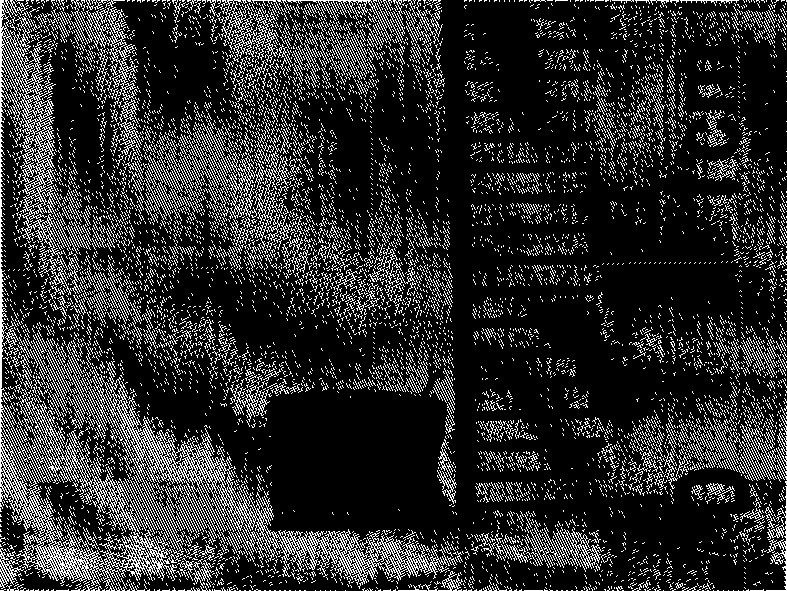Growth method of carbon nano-tube array
A technology of carbon nanotube array and growth method, which is applied in the direction of ion implantation plating, coating, metal material coating process, etc., can solve the problems of inaccurate temperature control, low energy utilization rate, slow temperature change, etc., and achieve temperature rise And the effect of fast cooling speed, improved energy utilization rate and fast growth rate
- Summary
- Abstract
- Description
- Claims
- Application Information
AI Technical Summary
Problems solved by technology
Method used
Image
Examples
Embodiment 1
[0026] 1) Using a silicon wafer as the substrate, first sputter 10nm aluminum oxide on its smooth surface, and then sputter a 2nm elemental iron layer on it;
[0027] 2) placing the iron-plated substrate on the heating sheet of the micro-zone heater;
[0028] 3) Start the micro-zone heating control power supply, use the silicon wafer as the heating plate, and set the temperature to 750°C;
[0029] 4) Pass argon, hydrogen and acetylene, the gas flow rate is 560sccm, 200sccm and 30sccm respectively;
[0030] 5) After reacting for 15 minutes, turn off the power supply of the micro-zone heating controller, take out the substrate, obtain samples and test them.
[0031] From figure 1 and 2 It can be seen that the grown carbon nanotube arrays are relatively uniform, with a length of 3.5 mm, good quality, few impurities, straight tubes, and close relationship between tubes and tubes. After 10 min of ethanol ultrasound, they are still arranged in bundles ( see image 3 ), the tube...
Embodiment 2
[0033] 1) Using a silicon wafer as a substrate, first sputter 10nm aluminum oxide on its smooth surface, and then sputter a 1nm elemental iron layer on it;
[0034] 2) placing the iron-plated substrate on the heating sheet of the micro-zone heater;
[0035] 3) Start the micro-zone heating control power supply, use the silicon wafer as the heating plate, and set the temperature to 750°C;
[0036] 4) Pass argon, hydrogen and acetylene, the gas flow rate is 560sccm, 200sccm and 30sccm respectively;
[0037] 5) After reacting for 15 minutes, turn off the power supply of the micro-zone heating controller, take out the substrate, obtain samples and test them.
Embodiment 3
[0039] 1) Using a silicon wafer as a substrate, first sputter 10nm aluminum oxide on its smooth surface, and then sputter a layer of 0.5nm elemental iron layer on it;
[0040] 2) placing the iron-plated substrate on the heating sheet of the micro-zone heater;
[0041] 3) Start the micro-zone heating control power supply, use the silicon wafer as the heating plate, and set the temperature to 750°C;
[0042] 4) Pass argon, hydrogen and acetylene, the gas flow rate is 560sccm, 200sccm and 30sccm respectively;
[0043] 5) After reacting for 15 minutes, turn off the power supply of the micro-zone heating controller, take out the substrate, obtain samples and test them.
PUM
| Property | Measurement | Unit |
|---|---|---|
| thickness | aaaaa | aaaaa |
| thickness | aaaaa | aaaaa |
Abstract
Description
Claims
Application Information
 Login to View More
Login to View More - R&D
- Intellectual Property
- Life Sciences
- Materials
- Tech Scout
- Unparalleled Data Quality
- Higher Quality Content
- 60% Fewer Hallucinations
Browse by: Latest US Patents, China's latest patents, Technical Efficacy Thesaurus, Application Domain, Technology Topic, Popular Technical Reports.
© 2025 PatSnap. All rights reserved.Legal|Privacy policy|Modern Slavery Act Transparency Statement|Sitemap|About US| Contact US: help@patsnap.com



